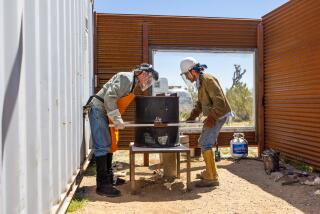Circling closer to a monumental work
- Share via
ROZEL POINT, UTAH — When artist Robert Smithson assembled a massive spiral unfurling into the Great Salt Lake 38 years ago, there was no indication that this remote spot would be altered again by humans any time soon.
Smithson’s work, called “Spiral Jetty,” became a world-renowned piece of art, its striking man-made pattern created amid isolation. Now art lovers fear it is threatened by plans to explore for oil a few miles offshore.
“The relationship between the work of art and the surrounding landscape is critical,” said Laura Raicovich, deputy director of the Dia Art Foundation in New York, which owns the sculpture.
“This is an internationally recognized work of art, which not just the people of Utah but everyone should want to maintain,” she said.
For decades, energy companies have known that oil sits beneath the Great Salt Lake. Indeed, the remains of a derrick lie a few hundred yards from “Spiral Jetty,” a 125-mile drive north and west of Salt Lake City on a shallow edge of the lake.
But there has been no exploration on the lake since the sculpture was created, state officials say. The oil is a heavy crude and costs so much to refine that it has been economically unfeasible to extract it.
That is until skyrocketing oil prices made it worthwhile for Calgary, Canada-based Pearl Exploration and Production. The company filed an application in January to explore underneath a stretch of the lake about five miles from the jetty.
More than 3,000 people from around the world have written to Utah officials in protest. Keith C. Hill, president and chief executive of Pearl, has also been swamped with correspondence.
“Not one,” he said in an interview, “has been supportive.”
Hill, who described himself as a “closeted environmentalist,” said that he understood the concern and that his company would keep the project as inconspicuous as possible. The only time the work would be visible from the jetty, he said, would be during the month or so of initial drilling from a large barge.
If the project goes into production, the Canadian company will build 16-foot-high rigs that will not be visible from the shore, Hill said.
Transport of the crude would be via buried pipelines or a barge that could be diverted far from the sculpture.
“I don’t have any issue with trying to do this in the lowest-impact, greenest way possible,” Hill said.
But Raicovich said the execution of this exploration wasn’t the only concern. If oil is found and it becomes profitable to extract it, that could set off a development boom in the area. Owners of subsurface rights closer to the jetty might want to let in energy companies too.
Smithson, who died in a plane crash three years after the jetty was built, was attracted to the site partly because of the remnants of old mining and energy exploration nearby. But Raicovich noted that Smithson’s photographs and films of the work were framed to exclude all human traces from the landscape.
Utah officials said they had delayed approval of the oil exploration pending more information on how Pearl would transport the crude.
The jetty is one of several artworks from the 1960s and ‘70s created in isolation in the West that are now threatened by development.
Builders hope to put up ranchettes near another Dia-owned artwork, “Lightning Field,” a group of 400 poles installed by artist Walter De Maria in the high desert of western New Mexico.
The federal government is planning to run train tracks to transport nuclear waste past artist Michael Heizer’s immense sculpture “City” in Nevada.
In Utah, reaching “Spiral Jetty” requires a final bone-jarring trek down 15 miles of dirt roads.
On a recent afternoon, the handful of people who made the journey basked in the solitude of the setting. They were dismayed at the idea of development here.
As a Westerner, Tricia Hancock of Logan, Utah, has become accustomed to watching places she once believed were untouchable be marred by energy development. Companies are drilling near her family ranch in the Wasatch Mountains.
“It’s changed the whole landscape, the whole look of the area,” said Hancock, 34. “I don’t recognize the landscape anymore.”
She and her husband, Curtis, watched their three children play on the rocks and contemplated the future of the artwork.
“It’s going to change this,” she said. “Even if it’s five miles out.”
--
nicholas.riccardi@ latimes.com
More to Read
Sign up for Essential California
The most important California stories and recommendations in your inbox every morning.
You may occasionally receive promotional content from the Los Angeles Times.













